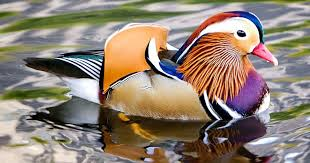Important Facts For Prelims
Mandarin Duck
- 18 Feb 2021
- 2 min read
Why in News
Recently, Mandarin ducks have been sighted in the Maguri-Motapung beel in Assam’s Tinsukia district after a century.
Key Points
- Scientific Name: Aix galericulata
- Discovery

- Mandarin duck was first identified by Swedish botanist, physician and zoologist Carl Linnaeus in 1758.
- Characteristics:
- It is considered the most beautiful duck in the world.
- Male mandarins have elaborate plumage (feathers) with orange plumes on their cheeks, orange 'sails' on their back, and pale orange sides; females are dull in comparison, with grey heads, brown backs and white eyestripe.
- Diet:
- These birds may feed on seeds, acorns, small fruit, insects, snails, and small fish.
- Habitat:
- These birds inhabit temperate forests near wetlands including rivers, streams, bogs, marshes, swamps, and freshwater lakes.
- It is native to East Asia but has established populations in Western Europe and America too.
- It breeds in Russia, Korea, Japan and northeastern parts of China.
- Presence in India:
- The duck rarely visits India as it does not fall in its usual migratory route.
- It was recorded in 1902 in the Dibru river in the Rongagora area in Tinsukia (Assam).
- More recently, it was sighted in Manipur’s Loktak Lake in 2013, and in Saatvoini Beel in Manas National Park and Tiger Reserve in Assam’s Baksa district in 2014.
- Status on IUCN Red List : Least Concern.
- Maguri-Motapung Beel:
- The Maguri Motapung wetland, an Important Bird Area as declared by the Bombay Natural History Society is located close to the Dibru Saikhowa National Park in Upper Assam.
- In May 2020, the Beel was adversely affected by a blowout and fire at an Oil India Limited-owned gas well.
- The resulting oil spill killed a number of fish, snakes as well as an endangered Gangetic dolphin.




